
The People's Army of Vietnam (PAVN), officially the Vietnam People's Army, also recognized as the Vietnamese Army or the People's Army, is the national military force of the Socialist Republic of Vietnam and the armed wing of the ruling Communist Party of Vietnam (CPV). The PAVN is a part of the Vietnam People's Armed Forces and includes: Ground Force, Navy, Air Force, Border Guard and Coast Guard. Vietnam does not have a separate Ground Force or Army service. All ground troops, army corps, military districts and special forces belong to the Ministry of National Defence, directly under the command of the CPV Central Military Commission, the Minister of National Defence, and the General Staff of the Vietnam People's Army. The military flag of the PAVN is the National flag of the Socialist Republic of Vietnam defaced with the motto Quyết thắng added in yellow at the top left.

Hồ Chí Minh, colloquially known as Uncle Ho or just Uncle (Bác), and by other aliases and sobriquets, was a Vietnamese communist revolutionary, nationalist, and politician. He served as prime minister of the Democratic Republic of Vietnam from 1945 to 1955 and as president from 1945 until his death, in 1969. Ideologically a Marxist–Leninist, he was the Chairman and First Secretary of the Workers' Party of Vietnam, the predecessor of the current Communist Party of Vietnam.

The Ho Chi Minh Trail, also called Annamite Range Trail was a logistical network of roads and trails that ran from North Vietnam to South Vietnam through the kingdoms of Laos and Cambodia. The system provided support, in the form of manpower and materiel, to the Viet Cong and the People's Army of Vietnam (PAVN), during the Vietnam War. Construction for the network began following the North Vietnamese invasion of Laos in July 1959. At the time it was believed to be the main supply route, however it later transpired that the Sihanouk Trail which ran through Cambodia was handling significantly more materiel.

Vietnam, officially the Socialist Republic of Viet Nam (SRV), is a country at the eastern edge of mainland Southeast Asia, with an area of about 331,000 square kilometres (128,000 sq mi) and a population of over 100 million, making it the world's fifteenth-most populous country. Vietnam shares land borders with China to the north, and Laos and Cambodia to the west. It shares maritime borders with Thailand through the Gulf of Thailand, and the Philippines, Indonesia, and Malaysia through the South China Sea. Its capital is Hanoi and its largest city is Ho Chi Minh City.
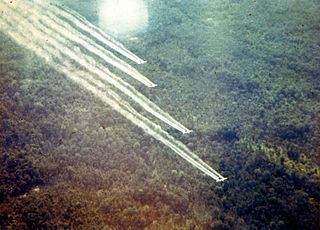
Operation Ranch Hand was a U.S. military operation during the Vietnam War, lasting from 1962 until 1971. Largely inspired by the British use of chemicals 2,4,5-T and 2,4-D during the Malayan Emergency in the 1950s, it was part of the overall herbicidal warfare program during the war called "Operation Trail Dust". Ranch Hand involved spraying an estimated 19 million U.S. gallons (72,000 m3) of defoliants and herbicides over rural areas of South Vietnam in an attempt to deprive the Viet Cong of food and vegetation cover. Areas of Laos and Cambodia were also sprayed to a lesser extent. According to the Vietnamese government, the chemicals caused 400,000 deaths. The United States government has described these figures as unreliable.
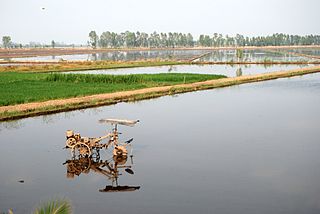
The Mekong Delta, also known as the Western Region or South-western region, is the region in southwestern Vietnam where the Mekong River approaches and empties into the sea through a network of distributaries. The Mekong delta region encompasses a large portion of south-western Vietnam of over 40,500 km2 (15,600 sq mi). The size of the area covered by water depends on the season. Its wet coastal geography makes it an important source of agriculture and aquaculture for the country.

Tây Ninh is a province in the Southeast region of Vietnam, with the capital at the town of Tây Ninh.
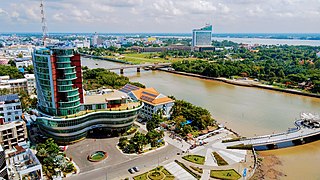
Cần Thơ, also written as Can Tho or Cantho, is the fourth-largest city in Vietnam, and the largest city along the Mekong Delta region in Vietnam.

Herbicidal warfare is the use of substances primarily designed to destroy the plant-based ecosystem of an area. Although herbicidal warfare use chemical substances, its main purpose is to disrupt agricultural food production and/or to destroy plants which provide cover or concealment to the enemy, not to asphyxiate or poison humans and/or destroy human-made structures. Herbicidal warfare has been forbidden by the Environmental Modification Convention since 1978, which bans "any technique for changing the composition or structure of the Earth's biota".
Environmental issues in Vietnam are numerous and varied. This is due in part to the effects of the Vietnam War, and also because of Vietnam's rapid industrialization following the economic reforms in 1986 known as Doi Moi, amongst other reasons. Officially, the Ministry of Natural Resources and Environment (MONRE) of the Socialist Republic of Vietnam lists environmental issues to include land, water, geology and minerals, and seas and islands, amongst others.

Long Thanh International Airport is an international airport under construction in Long Thành District, Đồng Nai Province, Vietnam, approximately 40 km (25 mi) east of Ho Chi Minh City. It will be the second airport to serve the Ho Chi Minh City metropolitan area, after the existing Tan Son Nhat International Airport. It is being built as an alternative to the existing airport, in order to relieve its increasing traffic, demand and congestion, as it could not be further expanded due to urban growth around it. The Government of Vietnam approved its construction on 4 January 2021. Construction began the next day on 5 January, and its first phase was scheduled to be finished by September 2025, but now it is expected to be finished by the first half of 2026. The airport will serve over 100 million passengers and five million tonnes of cargo annually when built to the maximum designed capacity, making it the largest airport in Vietnam, Southeast Asia and one of the largest in the world. The project is the most expensive infrastructure project in Vietnam's history. Once open, both the airports along with the existing one will operate together. The national carrier, Vietnam Airlines, is suggested by the project consultants as the only Vietnamese carrier to operate flights from Long Thanh, while other airlines will wholly stay at the existing airport.
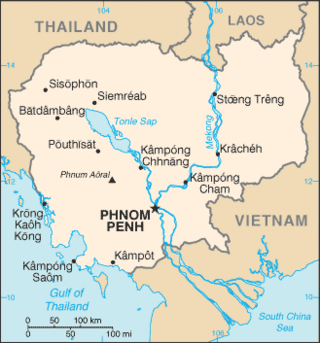
The Sihanouk Trail was a logistical supply system in Cambodia used by the People's Army of Vietnam (PAVN) and its Viet Cong (VC) guerillas during the Vietnam War (1960–1975). Between 1966 and 1970, this system operated in the same manner and served the same purposes as the much better known Ho Chi Minh trail which ran through the southeastern portion of the Kingdom of Laos. The name is of American derivation, since the North Vietnamese considered the system integral to the supply route mentioned above. U.S. attempts to interdict this system began in 1969.

The Rainbow Herbicides are a group of tactical-use chemicals used by the United States military in Southeast Asia during the Vietnam War. Success with Project AGILE field tests in 1961 with herbicides in South Vietnam was inspired by the British use of herbicides and defoliants during the Malayan Emergency in the 1950s, which led to the formal herbicidal program Trail Dust. Herbicidal warfare is the use of substances primarily designed to destroy the plant-based ecosystem of an agricultural food production area and/or to destroy dense foliage which provides the enemy with natural tactical cover.

The War Remnants Museum is a war museum at 28 Vo Van Tan, in District 3, Ho Chi Minh City (Saigon), Vietnam. It contains exhibits relating to the First Indochina War and the Vietnam War.

The Greater Mekong Subregion, (GMS) or just Greater Mekong, is a trans-national region of the Mekong River basin in Southeast Asia. The region is home to more than 300 million people. It came into being with the launch of a development program in 1992 by the Asian Development Bank that brought together the six Asian countries of Cambodia, China, Laos, Myanmar (Burma), Thailand, and Vietnam.
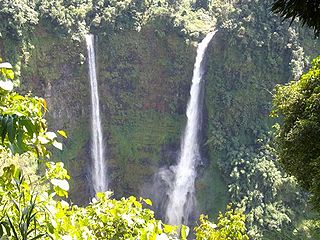
The Bolaven Plateau is an elevated region in southern Laos. Most of the plateau is located within Champasak Province of Laos, though the edges of the plateau are also located in Salavan, Sekong and Attapeu Provinces. It is located between the Annamite Range, along which runs Laos' eastern border with Vietnam, and the Mekong River to the west, at about 15°N106°E. The plateau's elevation ranges approximately from 1,000 to 1,350 metres above sea level. The plateau is crossed by several rivers and has many scenic waterfalls. The name Bolaven makes reference to the Laven ethnic group which has historically dominated the region. However, domestic migrations by the Lao ethnic group has resulted in widespread interethnic marriage, thus modifying the ethnic composition of the region.

Study of the environmental impact of war focuses on the modernization of warfare and its increasing effects on the environment. Scorched earth methods have been used for much of recorded history. However, the methods of modern warfare cause far greater devastation on the environment. The progression of warfare from chemical weapons to nuclear weapons has increasingly created stress on ecosystems and the environment. Specific examples of the environmental impact of war include World War I, World War II, the Vietnam War, the Rwandan Civil War, the Kosovo War, the Gulf War, and the 2022 Russian invasion of Ukraine.
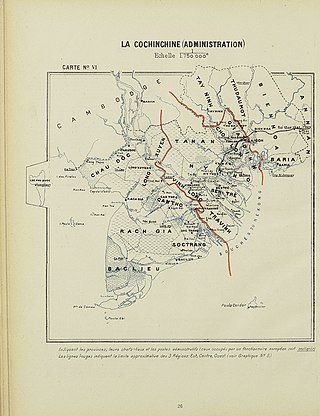
Kampuchea Krom is the region variously known as Southern Vietnam, Nam Bo, and the former French Cochinchina. Bordering present-day Cambodia, the region is positioned in Cambodian nationalist narratives as a "once-integral part of the Khmer kingdom that was colonised by France as Cochinchina in the mid-nineteenth century, then was ceded to Vietnam in June 1949".. Despite historical cessations with the latest one in 1770 to the rulling Nguyễn Lords of the period. In the present day, the region roughly corresponds to the Mekong Delta region of Vietnam.

The estimated hydropower potential of Mekong River Basin about 58,930 Megawatts (MW). As of February 2024, there are an estimated 167 Hydropower Plants (HPPs) in the Mekong, with a combined installed capacity of some 36,376.3 MW. An additional 20 HPPs are currently under construction and at various stages of completion. These have a combined installed capacity of an additional 4,535.5 MW.

Tran To Nga is a Franco-Vietnamese environmental activist. During the Vietnam War, she was a journalist, then a liaison officer for the National Liberation Front. After the war, she became a school principal before running a travel agency.

















